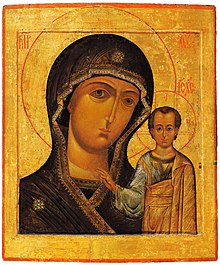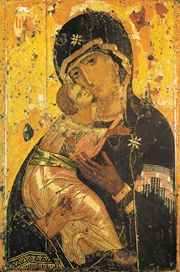I found this article its very well explained and may give you a better understanding of catholics beliefs.
Why do Catholics believe in the Immaculate Conception? The belief means that Mary, the mother of Jesus, was preserved without sin for her entire life.
The Immaculate Conception

It was Mary's closeness to Christ that made her receive God's "fullness of grace" to be sinless. Without God's grace, it would have been impossible for Mary to be sinless, and she too would be like the rest of humanity. However, because of her decision to say, "yes" in giving birth to Christ, she was given a special privilege by having no sin touch her. Catholics believe that God wanted a perfectly pure woman to carry His Son, the God of the universe, for nothing else short of perfection would do.The Immaculate Conception of Mary continues to be a major disagreement point by other Christian denominations towards the Catholic faith. Many people say that the Immaculate Conception somehow takes away from Christ's glory and message. Some will say that this belief in Mary is not found in the Bible, or that it blatantly contradicts the Bible's words. There are also thousands of people who mistakenly believe what the Catholic Church teaches about the Immaculate Conception, which unfortunately has lead to many misguided opinions. What evidence do Catholics have to defend their belief in Mary's Immaculate Conception?
Evidence from the Scriptures:
"And the angel came in unto her, and said, hail, full of grace, the Lord is with thee: blessed art thou among women." - Luke 1:28
It is the term "full of grace" that is emphasized by the Church when dealing with Mary's Immaculate Conception. The title "full of grace" comes from the Greek word
kecharitomene, which describes a "perfection" and "abundance" of grace. In other words, Mary was proclaimed by the angel to be with a perfection of grace, which was a very powerful statement. How can Mary be completely and perfectly with God's grace, yet still have sin left in her? Christians eventually came to recognize that it was extremely possible for Mary to be without sin, especially if she was completely filled with God's grace. Luke 1:28 happens to be the only place in the Bible where anyone is addressed with the important title of "full of grace."
"…the Holy Ghost shall come upon you, and the power of the Highest shall overshadow you: therefore also that holy thing which shall be born of you shall be called the Son of God." - Luke 1:35
Luke 1:35 shows Mary as the Ark of the New Covenant. According to the Old Testament, the Ark of the Covenant was the pure and holy vessel that held the Ten Commandments (the Old Covenant). The Ark was so holy in fact, that if anyone where to touch it they could actually fall down and die! It was housed in the Holy of Holies, which was a perfectly clean place where the Jewish high priests could enter only once a year according to their law (See Lev. 16:2-4). So how are Mary and the Ark related? The same language that describes God's "dwelling" place for the Old Ark is used again for Mary's
overshadowing by the Holy Spirit. Put another way, the Old Ark held God's Ten Commandments and could not be touched by human hands because of its holiness. Mary, the New Ark, holds the New Covenant in her womb, which is Jesus Christ. How much holier is Christ than the Ten Commandments? It only makes sense that for Mary to hold God in her womb, she too would be completely pure and without any sin.
"I will put enmity between you and the woman, between your seed (offspring) and hers; He (she) will crush your head while you strike at his (her) heel." - Genesis 3:15
What does the book of Genesis have to do with Mary's Immaculate Conception? Genesis 3:15 is the first passage in the Bible that refers to Jesus defeating Satan on the cross. It is also the first verse that shows us how Mary would become the New Eve. The seed of the woman, who would crush the serpent's head, is Jesus. The woman at enmity, or hostility with the serpent, is Mary. It was God who put this hostility between Mary and Satan (the serpent), and it is believed to be in the same
likeness as Christ's hostility for the seed of the serpent. What exactly does all this mean? For Mary to be like Christ in His hostility for Satan forever, it is very possible to say that this passage implies Mary's lack of sin. What better way is there to be in total hostility with Satan than to be in God's constant grace? As the New Eve, Mary undid the "no" of the Old Testament Eve by saying, "yes" to carry Jesus.
Evidence from History:
Pope Pius IX officially defined the doctrine of the Immaculate Conception in the year 1854. He did so with the understanding that this belief would help the Catholic faithful grow spiritually towards Christ. The belief that Mary was without sin was not "invented" as numerous people mistakenly think. Many are still under the false impression that the Immaculate Conception was not believed until the year 1854 when it was defined. What they fail to realize is that the belief itself has extremely strong roots in Church writings going well back into the 4th century.
"Every personal sin must be excluded from the Blessed Virgin Mary for the sake of the honor of God." - St. Augustine, 390 AD.
"Mary, a virgin not only undefiled but a virgin whom grace has made inviolate, free from every stain." - St. Ambrose of Milan, 340-370 AD.
"You, and your Mother are alone in this. You are wholly beautiful in every respect. There is in you, Lord, no stain, nor any spot in your Mother." - St. Ephraem, 350 AD.
In fact, there are literally dozens of cases where early Church fathers have mentioned Mary as being without sin, using such words as "All-Holy One," "All-Sinless One," and "Immaculate." It proves that the idea of Mary's sinlessness was not uncommon in the first few centuries of the Church. As time passed, the Eastern Church began to show its strong love for the Immaculate Conception with its own feast day beginning in the 8th to 9th century. By the 12th century, the Western Church was celebrating the feast of the Immaculate Conception all over Europe, and by the end of the 15th century, it was universally recognized and defended as true Christian doctrine.











